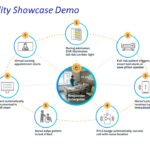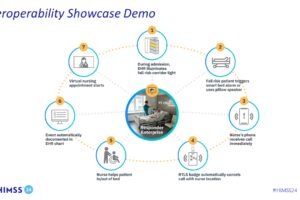The following is a guest article by Archie Mayani, Chief Product Officer, Enterprise Imaging, Cloud Solutions for Change Healthcare.
 Cloud solutions are becoming vital to healthcare providers’ ability to manage the needs of their patients. The COVID-19 pandemic reinforced the need to improve collaboration, bolster communication, and make it possible for all care team members to access patient data from anywhere at any time. The drive for secure, scalable accessibility continues to be at the forefront of the digital healthcare revolution.
Cloud solutions are becoming vital to healthcare providers’ ability to manage the needs of their patients. The COVID-19 pandemic reinforced the need to improve collaboration, bolster communication, and make it possible for all care team members to access patient data from anywhere at any time. The drive for secure, scalable accessibility continues to be at the forefront of the digital healthcare revolution.
Medical imaging, in particular, is an area rapidly shifting to the use of cloud-based solutions to help achieve organizational objectives. In a 2020 survey of U.S. healthcare providers commissioned by Change Healthcare, 94% of respondents planned to move some or all of their imaging into the cloud over the next five years. Cloud-based enterprise imaging allows providers to eliminate the burdensome, costly management of data centers while enhancing security and providing access to patient data needed by physicians at the point of care.
Despite the near-universal agreement on the benefits of cloud solutions, the transition to the cloud can seem overwhelming. Healthcare leaders today are asking questions such as: How should we begin planning for the adoption of cloud-based solutions? Will all cloud-based solutions offer the same quality, security, and agility? Does any solution provide the necessary scalability to grow with my organization?
The most innovative imaging vendors and industry pioneers are already using cloud solutions and realizing the benefits. As more healthcare providers design technology roadmaps that include cloud solutions, leadership teams should consider the following key factors to capture immediate and long-term value as they embark on their cloud transition.
What is the right cloud environment?
Understanding the nuances and differences between cloud environments is critical for healthcare leaders tasked with evaluating various technology vendors and solutions. Choosing the right cloud environment will help ensure your organization is selecting the best solution to meet your unique needs while providing an optimal return on your investment.
Cloud solutions can be housed in what is known as “public” or “private” infrastructures. Leveraging a public cloud provider offers a standardized infrastructure and vast scale, while private cloud environments are custom-built by a solution vendor. While both infrastructures have advantages and disadvantages, public clouds also provide standardized security at an infrastructure level, benefiting healthcare organizations. If providers decide to implement a private cloud solution, it is vital that the vendor follows the latest standards for interoperability and security at both the infrastructure and solution level.
In either cloud infrastructure type, many providers implement re-platformed solutions, also known as “lift-and-shift.” Simply put, the lift-and-shift process takes existing code from current technology solutions, with minimal modification, for use in a public or private cloud environment.
Conversely, cloud-native solutions are purpose-built for the cloud, leveraging the latest technologies created specifically for cloud computing. A few healthcare IT imaging vendors are choosing to design, build, and deliver cloud-native solutions. These vendors are leveraging cloud-native technologies to optimize cloud computing and capabilities such as microservices containers and continuous optimization.
Cloud-native architecture harnesses the cloud’s most powerful advantages: flexible, on-demand infrastructure and powerful managed services.This architecture allows cloud-native solutions to be always up-to-date without the disruptions of downtimes or planned upgrades. Healthcare organizations can also rest assured that the cloud-native solutions they use are built with future-proofing in mind, as they are aligned to third-party standards and dynamically scale both storage and computing power as needed. They also enable easy—and even automatic—feature and functionality updates as they become available.
The benefits of cloud-native healthcare solutions tied to upgrades and related downtime are potentially game-changing. Cloud-native solutions enable solution-wide, zero-downtime updates that typically require very little from providers in terms of resources. By eliminating the downtime associated with updates, cloud-native vendors can provide more frequent updates on a regular cadence—or as quickly as a few hours if there is a security threat. As a result of their build, cloud-native imaging solutions offer providers maximized value: exceptional deployment agility, optimal capabilities, and the architecture to meet healthcare data security requirements.
When choosing the right cloud solution, healthcare leaders should build relationships with vendors they trust that are certified in security best practices as defined by standards such as HITRUST® and SOC2— especially if pursuing a private cloud environment. Third-party certification ensures that a vendor has developed a highly secure cloud infrastructure that is safeguarded from cyber threats.
What is your ROI?
The decision to adopt an enterprise imaging cloud strategy is complex. As decision-makers weigh the level of investment, they first must determine their organization’s goals, identify potential cost savings, and specify their desired return on investment (ROI). This process includes modeling immediate and long-term ROI objectives.
For example, migrating a function such as medical image file storage and management to the cloud can positively impact cost in many ways. Let’s explore two ways costs can be lowered. First, when using cloud-based solutions, organizations can eliminate the upfront and recurring cost of hardware and application maintenance. Secondly, cloud-based solutions provide elastic storage for data. As providers only need to pay for the amount of storage they need, they no longer have to overprovision storage to accommodate any potential surges in data storage needs.
Simplifying the imaging information architecture also allows providers to eliminate redundant IT infrastructure, applications, and siloed data storage. Consolidating imaging systems makes data more available to clinicians and accessible for use in clinical decision support mechanisms, scaled interoperability, and other innovations that require secure patient data.
To realize a significant ROI, healthcare leaders must recognize the need for a well-informed strategy. Achieving ROI requires collaboration with both clinical and technical stakeholders within your organization. Selecting a vendor that understands all aspects of imaging and the needs of the stakeholders is critical when you begin defining, executing, and measuring outcomes for your strategic technology transition roadmap.
What does your roadmap look like?
When choosing a partner to help transition imaging to the cloud, it’s important that providers understand what their migration and solution roadmap looks like. Providers should ask questions like “How will the vendor be able to deliver solutions that meet my data storage and enterprise imaging needs?” and “How frequently are upgrades and updates released? What is the downtime associated with these updates?”
Taking a closer look at the vendor’s plans will be instrumental in realizing ROI and adopting an effective cloud solution. For example, it is critical that a vendor’s solution be interoperable with a provider’s current on-premises solution without sacrificing performance. If the solutions aren’t compatible, providers should know their options for upgrading in the future to ensure a seamless transition to the cloud. The image file management solution should also be interoperable with your organization’s electronic health record (EHR). These systems must be able to seamlessly communicate with one another in order to help healthcare providers complete their digital transformation.
What’s the best first step?
With the right partner and the right approach, migrating imaging solutions to the cloud can help healthcare providers realize cost savings, boost productivity, and enhance collaboration and innovation. Accessibility to imaging data is key to advancing AI, smoothing clinical workflow, and most importantly, improving the delivery of patient care in various delivery channels like telehealth.
Providers don’t need to take an “all-or-nothing” approach to cloud migration. In fact, starting small can help inform an organization’s larger transition strategy and help leadership recognize immediate opportunities to increase value. Given the 21st Century Cures Act and the mandate for patient imaging portals, a great first step for many providers is adopting an image sharing solution, such as Change Healthcare Imaging Share™. This cloud-based medical imaging exchange solution allows providers to share imaging data virtually among care team members and patients. Currently, many providers are still sharing medical imaging data via a CD, representing significant waste from a cost and environmental perspective. Image sharing solutions address this issue by enabling providers to access and view imaging data virtually at the point of care. These solutions are categorized as low-implementation and serve as a great gateway to cloud adoption.
Other organizations may seek to capture initial ROI at a larger scale as they enter the cloud for enterprise imaging. As mentioned earlier, moving medical imaging files to the cloud for storage and management offers the opportunity to greatly reduce or even eliminate off-site data centers and local storage (and their associated management), provided the cloud imaging file management solution in question works seamlessly with solutions that need to remain on-premise for the moment (e.g., PACS). This change can help ensure that your performance is on par or better than the current state.
Depending on the age and provider of the systems currently in place, this may require a transitional upgrade or the replacement of some on-premise solutions. Such upgrades should also offer additional ROI on their own via greater efficiencies, better integration with AI, and improved security over older systems. The vendor’s roadmap and pricing model should always offer demonstrable return on investment at every step, as well as a credible path to complete cloud migration over time.
Addressing these questions and determining the right path for your organization will be core to the success of any enterprise imaging cloud transition. Take the time to evaluate what your specific cloud transition will look like, where you want to go, and how the solution will continue to deliver new value over time. Moving to the cloud is a big step for any healthcare organization, but it’s one with a track record of delivering scalable solutions to significantly improve functionality and help you realize cost savings.













